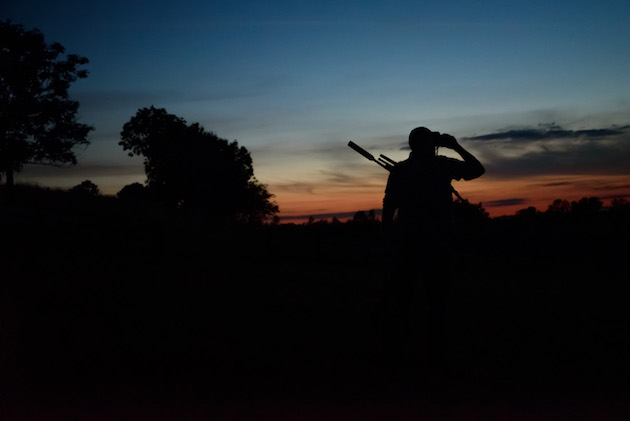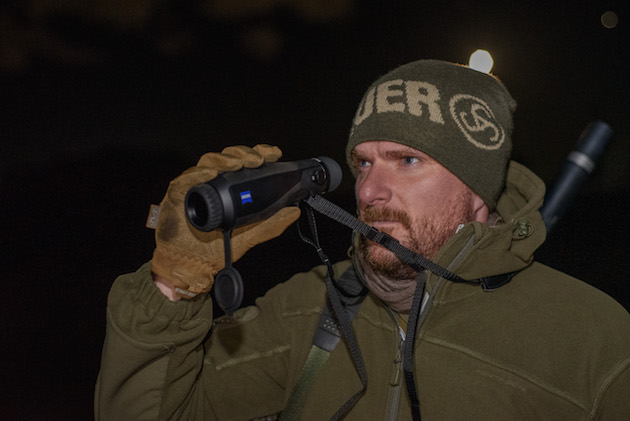How to use thermal imagers safely
Thermal imaging is an incredibly powerful tool to aid and assist us but immersion in what becomes a new world must be cautiously addressed, warns Chris Parkin

The time to use your thermal imager is after you have fully taken on board the weather and light conditions out there.
Before using a thermal imager
The human brain learns from birth to process a colourful, bright visual world. Our brains subconsciously assess distance, speed, size and the many other factors we see 24 hours a day.
So it is key to take the time to get naturally acquainted with the visual world that awaits before relying too heavily on your thermal units. Use your brain to assess how what you are seeing is affected by elements such as the prevailing air conditions. The time to use your thermal imager is after you have fully taken on board the weather and light conditions out there.
Tips on using a thermal imager safely
When you are looking at a bright light with the internal screen in darkness, natural night vision in the eye used behind the screen will diminish. Although a large percentage of human night vision is controlled by the pupil enlarging to its maximum diameter, allowing more light in, the brain alters its own signal processing to accept information from rod cells instead of cones to account for less intensive greyscale, rather than stronger colour-oriented vision.
All this occurs whilst chemicals within the eye are losing their sensitivity. The widening pupil accounts for a large percentage of light entry and processing with quick effects, the chemical resources take time to regenerate within the body and once bleached out, take hours to regain full sensitivity. This is all entirely normal but the more you research, the more you learn. It is no different from why when you wake up to a room full of light from sleep, it initially seems abnormally bright.
If using a monocular, beware of imbalance from your eyes which can confuse the brain. This may all sound a little serious but it affects some people a lot more than others and factors like migraines and headaches are not particularly rare.
Beware these factors when walking, possibly alone at night, in intrinsically rural locations as whatever is dangerous in daylight (uneven ground, cliffs, rivers etc) is more so at night, and even worse with impaired natural night vision and balance diminished. Loss of binocular vision (two independently mobile eyes able to gauge distance from their angular spread) is another subtle factor we lose. “Bi-ocular” and “binocular” are not interchangeable terms!

Thermal riflescopes enable shooting in total darkness with additional infra-red light and often see partially obscured quarry
Be aware of surroundings
You also need to remain aware of all surroundings just as you are in daylight. Although thermal helps to illustrate possibly dangerous heat sources like trespassers and farm animals, it won’t show all the ambient items like fences, barbed wire, intervening foliage etc. More sensitive units may well detect fractions of a degree temperature variation between a steel wire and ambient air but not all can. A bullet clipping a steel wire in flight has serious consequences, perhaps a safe miss, but a ricochet or dangerous non-lethal wounding shot cause major problems.
What are you looking at?
We all make mistakes in identification at any time and using thermal imaging tools adds new hurdles. Some are helpful in that you see more and relax somewhat as a result, feeling more in command of the ‘visual’ environment. The flip side is image quality and pixilation of that image are constant factors. We used to spend thousands of pounds for the ultimate image quality in optical binoculars and riflescopes. Yet that might only be entry to mid-level capability on thermal units which are never going to render similar levels of detail. Body shapes, ears, tails and manes are all items that are one shape and colour in daylight but show a vastly dissimilar structure thermally.
Learn your land, location and quarry species from a personal thermal perspective. I enjoy being able to observe animals unseen and unstressed for as long as wind direction is favourable, helping me learn more about character and habits in darkness with no fear of the animal knowing it is being observed and disturbed. Every animal behaves differently under stress than in its natural state. They like us, are all actors where an audience changes the ‘screenplay’

The latest sensors give an image of totally immersing you into former darkness
After the shot
It’s often possible to see hot bullets, blood splatter and flesh exit the body of an animal and although some is seen in daylight, thermally this can be more illustrative of a good or bad shot. The flip side is that the hot blast from a rifle, as well as recoil, can obscure the image for that fraction of a second.
So, as always, make sure of the shot and correct distance/aimpoint before the shot is taken. Rangefinding in darkness is a new factor and laser rangefinders are becoming more common on a thermal imager; they are helpful and worth their cost if regularly venturing onto new land. I wouldn’t take on board too much marketing hype about making long range thermal shots. Their ‘assured’ long range capability and multiple zeroing distances might sound enabling but a low-resolution digital image and possibly bulky crosshair won’t currently allow aimpoint placement quite as optically precise as day scopes with dialling capability. Knowing the range is also a key factor in gauging quarry size and not falling in the trap of two animals in close proximity merging into one larger species.
Comfortable to hold and handy in the field – the new Zeiss thermal imaging monocular
Look up the dictionary definition of the word ‘ergonomic’ and you’ll see that it means ‘designed for efficiency and comfort…
A night vision IR based riflescope paired to a thermal spotter can offer a helpful secondary visual style with helpful detail perspective to that of a thermal imaging only picture. It can also clearly illustrate where the thermal almost ignores light vegetation that may once have obscured quarry. Swapping to night vision clearly illustrates (often with strong reflected IR illumination) the intervening obstacles to a safe shot.

ZEISS DTI 3-35 is one of the first thermal imagers from an established optical powerhouse
Conclusion
A thermal imager is a great aid when following up downed game. Finding a carcass that is invisible to the naked eye in just short cover can be straightforward with its residual heat on display for several hours. As a tool in your hands, it makes follow-up easier, less stressed and removes the need to take risky shortcuts across difficult terrain.
Finally, although many of us love to shoot alone, if you have a companion without thermal, don’t forget they can be comparatively “blind” compared to you, so hold your patience and work on combining the information only you are aware of.
Thermal imaging is a fantastically empowering new capability and worth every effort to get to know. Trust trust it and benefit from it safely where legally allowed, regardless of specific hunting style.








